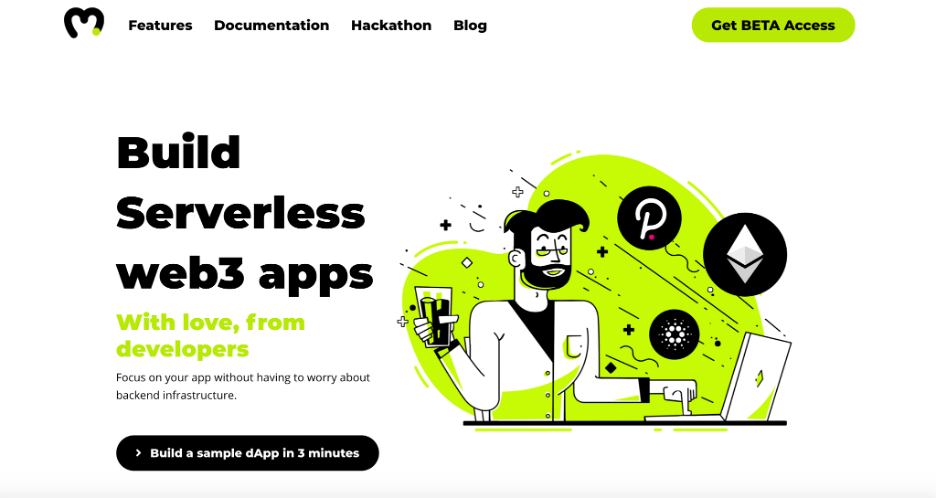Today, blockchain and Web3 are all the rage, with dApps taking center stage, attracting attention from users and developers alike. We are in an exciting new frontier where decentralized applications can be created. The result is an explosion of creativity, and numerous decentralized applications or dApps making headway into many different industries – fintech first and foremost, but also identity, insurance, intellectual property, the arts, and others. The demand for blockchain, Web3, and dApp skills is at an all-time high. And one of the keys to entering this brave new world of decentralized invention is knowledge of one ubiquitous language: JavaScript. To make the most out of the new opportunities ushered in by this new development landscape, devs should understand how to use Web3 with JavaScript and “Web3.js”.
So, what is JavaScript? If you are an experienced developer with a track record of building websites from scratch using HTML, CSS, and JS, then you are no stranger to the wide applications of this scripting language. It is a standard part of any experienced web developer’s toolkit. However, if you are a beginner, you will find that learning JavaScript is one of the key foundations for starting a programming or web development career. Beyond the development of websites, it also opens doors to more career opportunities leading into the internet trend of the future: Web3. We’ve previously answered the question “What is Web3?” in another comprehensive guide.
Already interested in blockchain? Find new ways to create and interact with blockchain platforms using Web3 JavaScript or Web3.js, a library that allows you to connect dApps and run off-chain smart contracts asynchronously with well-known blockchains like Ethereum. Web3.js is an important part of the blockchain and smart contract ecosystem, allowing dApps to interact with blockchain networks.
What is JavaScript and Web3.js?
No matter where you are in your programming or development career, JavaScript is an immensely useful tool for you. As a beginner interested in learning JavaScript, you will need to understand what it is, what it’s used for, and where it fits in your skillset or stack, should you decide to use it.

JavaScript fits into a three-tiered stack needed to develop or create websites. Think of it as three steps on a ladder or three layers on a cake. You can even imagine them as three legs, as in a tripod. These layers work together in web design. Before we move onto Web3.js, let us first look at the three basic layers of web design.
Three Layers of Web Design
The first layer is HTML. HTML, or Hypertext Markup Language, is often referred to as the “structure layer”. HTML creates a framework for the site. It is the initial step where all the user content is stored. It can be made up of both images and text. It also consists of hyperlinks used for navigation.
The second layer is the styling layer. It controls the look or appearance of your site. The language used for this is CSS, or Cascading Style Sheets. CSS instructs how the content is displayed on a browser and is used to add style and do layouts on a web page. With CSS, you can do more than just post plain text and information. Some of these functions include customizing fonts and adjusting the entire appearance of your content, from spacing to the number of columns to adding other illustrative features to make it more user-friendly. CSS is important for creating the visual frame and can be used to adapt to different screen sizes.
The third layer of web design is – you guessed it – JavaScript. JavaScript breathes life into a website. It is the behavioral layer that adds interactivity. What do we mean by this? After the site has its basic framework, you’re ready to dress it up – to put in the features that make the experience truly richer for the user. Beyond HTML and CSS, this language lets you transform the content into something more dynamic.
JavaScript Interactivity
JavaScript offers greater breadth and versatility, lets you add and control multimedia, and allows you to update your content interactively. It also allows you to animate your images and offers a great deal more flexibility than the previous two. It’s important to note that all three languages complement each other and can be built on top of one another without issues.
Now that you have the basic answer to “What is JavaScript?” and have an idea of its most common uses, you’re ready to move on towards understanding Web3 development with JavaScript and Web3.js.
A Deeper Dive: How to use JavaScript?
JavaScript, or JS, is an example of a scripting language. What does that mean? It means that it is used for automation to free users of things they will otherwise have to do themselves in a series of steps. It eliminates the need to manually reload a web page. It tells a website or application to perform a task, thereby doing most of the legwork. It instructs images to move or animate, so it appears that these things are happening spontaneously or independently. You can type the commands directly into HTML, requiring no additional compilers and programs.

In summary, with JavaScript you can:
- Develop mobile apps
- Build browser-based games
- Go beyond static and make websites more interactive
If you are further along or more advanced with some experience in blockchain or Web3, Web3 JavaScript is integral to your skillset. It can:
- Do other things on decentralized platforms. It allows users or software that is off-chain to interact with the blockchain by relaying the transaction to on-chain components (more on this later.)
Career Advancement for Beginners and Novices: Expand your Prospects with Web3 JavaScript and Web3.js
As an aspiring programmer or novice web developer looking to take your skills to the next level, you go to Ivan on Tech Academy for a JavaScript course to launch or refresh your career. As a beginner, these courses can help you further answer the question, “What is JavaScript?” As a novice, you can add JavaScript or Web3 JavaScript to your HTML and CSS skills. If you learn fast, it can introduce you to new prospects in your career, and get you on track to working with Web3 JavaScript on blockchain-related projects.

Kickstart your career today! Get access to new opportunities by learning JavaScript now through Ivan on Tech Academy’s concise and well-explained online programs. This will make you ready for using Web3.js yourself!
Web3.js Opens up a World of Discovery
If you are an experienced developer looking to jumpstart your career and take advantage of the innovations in today’s web, learning Web3 JavaScript or Web3.js is the way to go. Many buzzwords are being thrown around, like blockchain, smart contracts, Web3 and dApps. To make sense of these new trends, you first need to understand these concepts which are built around the idea of decentralization. Later on, you will learn how to use Web3 with JavaScript.

A Decentralized Architecture Overview: What is Blockchain?
Blockchain is the technology behind Bitcoin and many other cryptocurrencies. But in itself, it can be something more. In the simplest of terms, it is a public digital ledger. Many also define it as a database.
A blockchain allows information to be compiled on a public ledger that is accessible and readable by anybody. Once this information is logged, it is considered immutable or incapable of being erased.
After Bitcoin, many have attempted to create their own blockchains with varying success. Ethereum first took the concept of a blockchain to create a new ecosystem that performs more complex functions than just money or currency.
With Ethereum, servers or clouds are replaced with a node network. These nodes, just like Bitcoin, hold a copy of the network transaction history in the form of a blockchain. To agree on the truth of these transactions, the nodes need to reach consensus. However, Ethereum, unlike its simpler predecessor, was designed to be Turing-complete. To achieve consensus, it abides by more complex rules, determined by smart contracts.
What is a Smart Contract?
A smart contract is a remarkable concept. First proposed by Nick Szabo in the 1990s, it has grown to be applied in Bitcoin and many other cryptocurrencies and digital platforms. It is a way to implement, ensure, secure, and formalize relationships on public networks. It means that for consensus to be achieved in the network, and for nodes to validate a transaction, certain criteria or conditions must be met.
Bitcoin was the first to implement a smart contract. Since then, smart contracts have grown in scale and have become more ambitious. What does this mean? It means that decentralized systems are now able to agree on a set of laws that are beyond the simple ones first conceived in the Bitcoin protocol.
Ethereum and other “Ethereum-killers” or rivals propose a more sophisticated consensus mechanism that allows users the opportunity to independently write their program. In other words, it will do what it was written to do.
It allows for more freedom of design. For example, it can manage multi-party agreements to a more complex degree, allowing a higher level of customization in such agreements. It can also act as a means of information storage. For example, in terms of domain registration. Another popular and highly valuable application is multi-sig. Multi-sig accounts allow multiple owners to co-sign on a transaction, and the transaction (e.g. spending of funds) does not happen when not enough owners agree to it.
It is often difficult to explain smart contracts because of their remarkable breadth and level of abstraction. But you can think of a smart contract as, at its very core, a software-based transaction between parties that is secured and implemented online without the need for a trusted third party to authenticate them. Moreover, they come with a set of rules that the network agrees to, and can arbitrarily construct using software tools.
Relevance to Web3
Web3 is sometimes dubbed “the internet of blockchains”. Beyond Web 1.0 and Web 2.0, Web3 is all about moving into decentralization and self-governance.
Web3 improves on our experience of the internet, adding important principles like trustlessness, self-governance, independent verifiability, permissionlessness, and internet-native payments. It runs on crypto-economic protocols, derived from the very principles started by decentralized currencies. What’s more, Web3 is where Web3.js, or interacting with Web3 using JavaScript, comes in.
In Web3, there is no centralized server or cloud. Instead, developers build and deploy over decentralized blockchains or P2P node networks. Check out our previous article for the best blockchain node provider when you are developing Web3 apps with JavaScript.
What are dApps?
The applications built on such decentralized infrastructure are called dApps. To the user, they may not appear any different from your conventional centralized app. But on the back end, they are very different.
There are two sides to working with applications on the blockchain. The first is the development of smart contracts and code that are deployed on the blockchain, which requires knowledge of the language primarily required to write on Ethereum, which is Solidity. The second is the development of clients or websites interacting with the blockchain. In other words, writing off-chain code capable of reading and writing on-chain data using smart contracts. This is where Web3 JavaScript comes in:
The Web3.js Library: How to Use Web3 with JavaScript
By now, you should be curious about how to use Web3 with JavaScript. This is relevant in the second aspect of developing for and working with blockchains, which is building applications that interact with them. How is this made possible? It is done through Web3 JavaScript, or Web3.js.

What is Web3.js? It is a collection of libraries that provides devs with a way to interact with the main blockchain. It allows you to connect with Ethereum nodes. For example, if you create off-chain software or an app that needs to transact on the blockchain, you will need Web3.js to facilitate the connection with a node, which then relays your transaction to the network.
The process by which a node receives such information and relays it to the network will not be covered by this article, but you can learn more by enrolling in courses like the ones Ivan on Tech Academy offers for blockchain and Ethereum dApp programming.
Simplify the Web3 JavaScript Process: Build and Prototype dApps with Moralis
By now you have an idea of what stack you need to get started using the blockchain, Web3, and dApps. You understand the importance of learning how to use Web3 with JavaScript. While you do need certain competencies to start, the process of building dApps is made much easier with Moralis.

With Moralis, you don’t have to go through the complicated process of building dApps from scratch. You can focus on things like user experience while worrying less about back-end infrastructure. Moralis offers developer features like user profile solutions that merge Web2 and Web3 and allow authentication using Metamask and other wallets. It also allows syncing of data in real-time among users. In addition, you can get webhook and socket alerts for new events on the blockchain. All of these features and more are in one convenient platform.
It’s an exciting new world that will open you up to the possibilities of building apps over a decentralized network. If there’s a sure way to jumpstart your career prospects, create new products for your startup or just challenge yourself to get creative, this is it. Get started with Moralis now and get early access to these amazing tools!
